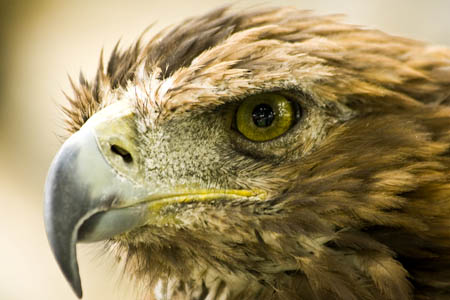A charity is offering a £1,000 reward after the discovery of the body of a golden eagle, which it said suffered a lingering death.
The Royal Society for the Protection of Birds Scotland said the body was found lying face down, with its wings folded, under a tree branch, close to a layby on a quiet country road near Aboyne, and was seized as evidence by officers from Grampian Police.
The eagle, which had a satellite transmitter attached to it, was found on 5 May this year. Both its legs were broken.
The carcass was taken for a post-mortem examination at the Scottish Agricultural College laboratory in Aberdeen. This concluded that the bird had suffered two broken legs due to trauma ‘that could be consistent with an injury caused by a spring-type trap’ and that the severity of these injuries ‘would prevent the bird from being able to take off’.
Ian Thomson, RSPB Scotland’s head of investigations, said: “It is disgraceful that this magnificent bird was subjected to such suffering.
“The post-mortem evidence suggests that this bird was caught in an illegally set-trap, smashing both legs. The data obtained from the satellite transmitter indicated that the eagle did not move from one spot on a hill high above Glen Esk, for over 15 hours.
“Then, during the night, when eagles do not readily fly, it has inexplicably moved to a new position, hidden under a tree and close to a road. Here, over the next four days, this eagle suffered a lingering death.”
An RSPB Scotland spokesperson said: “The bird had been fitted with a transmitter by RSPB Scotland staff, in full partnership with a local landowner, a few days before it had fledged from a nest in the Monadhliath Mountains, south-east of Inverness, in July 2011.
“By re-examining the satellite data, staff discovered the young bird spent its first few months in its natal area before venturing further afield. By April 2012 it was frequenting an area of upper Deeside, before moving south-west into Glenshee.
“On 28 April, the bird moved eastwards into Angus. The following day, at 6am, the bird was located on a hillside overlooking Glen Esk. Over the next 15 hours, a succession of satellite tag readings, accurate to within less than 20m, showed that the bird did not move from this precise spot until at least 9pm that evening, after nightfall.
“However, by 4am the next morning, 30 April, according to transmission data, it appeared to have travelled during the hours of darkness, some 15km north, to the location where its body was subsequently discovered some five days later.
“Satellite readings revealed that whilst the bird did not move from this position, it was probably alive until 4 May.”
Follow-up enquires by both Tayside and Grampian Police found no further evidence as to how the eagle came to suffer its injuries, nor could it be established how the eagle came to move from Glen Esk to a position under a tree branch on Deeside overnight.
However, a number of eagle down-feathers were found between the lay-by and the bird’s final resting place.
Stuart Housden, RSPB Scotland director, added: “Anyone who cares about our wildlife will be disgusted by what appears to be an appalling crime and the lengths taken to hide the facts from discovery.
“While efforts to stamp out the illegal poisoning of birds of prey are perhaps beginning to yield results, this dreadful case shows that the persecution of our raptors continues through the use of traps and other means.
“We call upon anyone who can provide further information about this case to contact the wildlife crime officer at either Tayside or Grampian Police without delay.
“Cases like this really do have a negative impact on Scotland’s reputation as a country that respects and values all its wildlife heritage.
“I am today offering a £1,000 reward for information that will assist a successful prosecution.”
